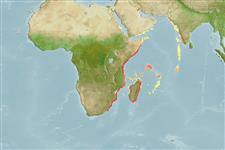Environment: milieu / climate zone / depth range / distribution range
Sinh thái học
Biển; Nước ngọt; Thuộc về nước lợ gần đáy; Di cư sông biển (để đẻ trứng) (Ref. 51243). Tropical
Africa: Kenya to South Africa (Ref. 3506), uncommon south of the Save River (Ref. 7248, 52193). Also Reunion and Mauritius (Ref. 33390). Dominant eel species in the Zambezi system and farther north in East Africa (Ref. 52193).
Bộ gần gũi / Khối lượng (Trọng lượng) / Age
Maturity: Lm ? range ? - ? cm
Max length : 175 cm TL con đực/không giới tính; (Ref. 48660); Khối lượng cực đại được công bố: 20.6 kg (Ref. 52193); Tuổi cực đại được báo cáo: 15 các năm (Ref. 48660)
Các tia vây lưng cứng (tổng cộng): 0; Tia cứng vây hậu môn 0.
Migratory species which breeds in the ocean (Ref. 52331), it requires rivers and oceans (Ref. 30558). Young fish migrate upstream with a continued feeding mode, especially on invertebrates found on rocks and logs washed by fast moving waters (Ref. 30558). They inhabit various niches in a river system (Ref. 13337) and penetrate far inland, surmounting formidable barriers in its upstream migration, including the Kariba and Cahora Bassa dams (Ref. 52193). Adults need moving water to migrate back to the ocean, especially after heavy rains (Ref. 30558). Their food consists of crabs, frogs and insects (Ref. 30558), and even fish, including trout in the streams of the eastern highlands of Zimbabwe (Ref. 2478, 52193). Caught with various types of nets.
Life cycle and mating behavior
Chín muồi sinh dục | Sự tái sinh sản | Đẻ trứng | Các trứng | Sự sinh sản | Ấu trùng
Skelton, P.H., 1993. A complete guide to the freshwater fishes of southern Africa. Southern Book Publishers. 388 p. (Ref. 7248)
IUCN Red List Status (Ref. 130435)
Threat to humans
Harmless
Human uses
Các nghề cá: Tính thương mại; cá để chơi: đúng
Thêm thông tin
Các tài liệu tham khảoNuôi trồng thủy sảnTổng quan nuôi trồng thủy sảnCác giốngDi truyềnElectrophoresesDi sảnCác bệnhChế biếnNutrientsMass conversion
Các công cụ
Special reports
Download XML
Các nguồn internet
Estimates based on models
Preferred temperature (Ref.
123201): 25 - 28.7, mean 27.1 °C (based on 306 cells).
Phylogenetic diversity index (Ref.
82804): PD
50 = 0.5000 [Uniqueness, from 0.5 = low to 2.0 = high].
Bayesian length-weight: a=0.00074 (0.00040 - 0.00138), b=3.18 (3.02 - 3.34), in cm total length, based on LWR estimates for this species & Genus-body shape (Ref.
93245).
Mức dinh dưỡng (Ref.
69278): 3.8 ±0.7 se; based on size and trophs of closest relatives
Thích nghi nhanh (Ref.
120179): thấp, thời gian nhân đôi của chủng quần tối thiểu là 4.5 - 14 năm (tmax=15).
Fishing Vulnerability (Ref.
59153): Very high vulnerability (90 of 100).
